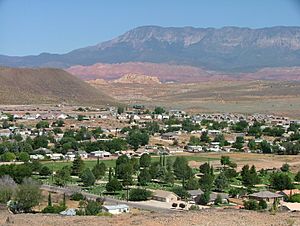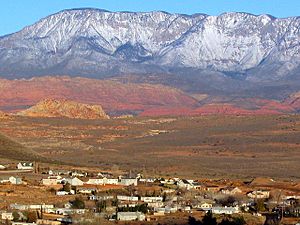Hurricane, Utah facts for kids
Quick facts for kids
City of Hurricane
|
|
|---|---|

Hurricane, Utah in July 2009
|
|

Location in Washington County and the state of Utah
|
|
| Country | United States |
| State | Utah |
| County | Washington |
| Area | |
| • Total | 53.63 sq mi (138.90 km2) |
| • Land | 52.76 sq mi (136.64 km2) |
| • Water | 0.88 sq mi (2.27 km2) |
| Elevation | 3,258 ft (993 m) |
| Population
(2020)
|
|
| • Total | 20,036 |
| • Density | 361.55/sq mi (139.60/km2) |
| Time zone | UTC-7 (Mountain (MST)) |
| • Summer (DST) | UTC-6 (MDT) |
| ZIP code |
84737
|
| Area code(s) | 435 |
| FIPS code | 49-37170 |
| GNIS feature ID | 2410082 |
Hurricane (/ˈhɜːrɪkən/ hur-IH-kən) is a city in Washington County, Utah, United States. Its population was 20,036 as of the 2020 United States Census estimates. The Hurricane valley makes up the easternmost part of the St. George metropolitan area and is near Zion National Park. Hurricane is known for its historic peach and pecan orchards, open space, and green fields.
Contents
History
Hurricane was first settled in 1896 and received its name after a whirlwind blew the top off a buggy in which Erastus Snow was riding. Snow exclaimed, "Well, that was a Hurricane. We'll name this 'Hurricane Hill'."
Hurricane, which is pronounced "Her-ah-kun" by local residents (mimicking the accent of early Liverpudlian settlers), is in eastern Washington County. The community was settled as part of The Church of Jesus Christ of Latter-day Saints's (LDS Church) President Brigham Young's "Cotton Mission", intended to establish the southern end of Utah for agricultural purposes. The town once operated a large peach and apricot orchard for the LDS Church and is historically known for small farms of peaches, pecans, and pistachio nuts.
The 1992 St. George earthquake destroyed three houses and various utilities, causing about US$1 million in damage.
Places of interest
The town has multiple parks, a dog park, a city pool and large community center, several ranked golf courses, two recreational reservoirs (Sand Hollow and Quail Creek State Parks), and a small municipal airfield. The Hurricane Valley Heritage Park Museum is located on the corner of State Street and Main. The area has several medical clinics.
Hurricane Canal was focal to the Hurricane Valley for approximately 80 years. It was built in 11 years (1893–1904), mostly by pick and shovel. Since 1985, the canal has been empty. In 2000, special interest groups came together to preserve the canal, receiving grants and volunteering time to construct a trail in tribute to the efforts the early settlers put forth to make the canal a reality. A monument at the trailhead briefly recounts the canal story. Much of the trail, which covers a small section of the canal, is the actual west bank of the canal, which "canal riders" rode every day when the canal was in operation to ensure there were no leaks or other problems, because the bank was somewhat unstable. The trail provides views of the towns of Hurricane and La Verkin throughout. The trail ends before reaching the Virgin River Gorge, approximately five miles from the canal's former headwaters.
Sand Hollow State Park contains a 1,322 acre reservoir, multiple camping locations, and off-roading trails, and is located in the south part of Hurricane. In addition to the sand beaches which are open to OHV's, the state park provides tunnel access across Utah State Route 7 to the neighboring Sand Mountain, which houses the popular Hurricane Sand Dunes. Sand Hollow can be accessed from Utah State Route 9, via Sand Hollow Road, or from the State Route 7.
Quail Creek State Park has a 600-acre reservoir and a campground. The reservoir it partially fed by Quail Creek to the north. The reservoir is for fishing, boating, kayaking, and paddle-boarding. The state park can be accessed from either State Route 9 or Old Highway 91 via 5300 W/State Route 318.
The Virgin River forms nearly all of Hurricane's north border. It travels through the city's Confluence Park and crosses State Route 9 at both the Hurricane-La Verkin border and near Quail Creek 3 miles from Harrisburg Junction. The river indirectly provides water to Hurricane and most of Washington County.
Geography
According to the United States Census Bureau, the city has a total area of 31.5 square miles (82 km2), of which 31.1 square miles (81 km2) is land and 0.4 square miles (1.0 km2) (1.39%) is water.
Transportation
U.S. Interstate 15 forms part of the northwest border of Hurricane. It has one exit, exit 16, that is located in Hurricane, and another exit, exit 27, that provides access to Hurricane from the north. I-15 is the main means of transportation to nearby St. George and also connects the town to Salt Lake City, 290 miles to the north, and Las Vegas, 138 miles to the south.
Utah State Route 9 begins in Hurricane, at Harrisburg Junction. It travels east through Hurricane, forming State Street. SR-9 links Hurricane to the nearby Zion National Park and to U.S. Route 89. State Route 9 is also Hurricane's main connector to I-15.
Utah State Route 59 ends in Hurricane, at the intersection of SR-9 and Main Street. It connects Hurricane with the nearby Hilldale and indirectly connects Hurricane to Kanab and Lake Powell through Arizona State Route 389.
Utah State Route 7, also known as Southern Parkway, when finished with construction, will begin at State Route 9 just south of Hurricane's business district and provide access to Washington and South St. George. State Route 7 has its western terminus just north of the Arizona border in St. George where it becomes Sun River Parkway at I-15.
Hurricane Municipal Airport, located in the south of Hurricane, is the city's only public airstrip. It has only one runway, no taxiway, and only services small personal aircraft.
Demographics
| Historical population | |||
|---|---|---|---|
| Census | Pop. | %± | |
| 1910 | 336 | — | |
| 1920 | 1,021 | 203.9% | |
| 1930 | 1,197 | 17.2% | |
| 1940 | 1,524 | 27.3% | |
| 1950 | 1,271 | −16.6% | |
| 1960 | 1,251 | −1.6% | |
| 1970 | 1,408 | 12.5% | |
| 1980 | 2,660 | 88.9% | |
| 1990 | 3,915 | 47.2% | |
| 2000 | 8,250 | 110.7% | |
| 2010 | 13,748 | 66.6% | |
| 2019 (est.) | 19,074 | 38.7% | |
| U.S. Decennial Census | |||
At the 2010 census, there were 13,748 people, 4,609 households and 3,545 families residing in the city. The population density was 540 inhabitants per square mile (210/km2). There were 5,461 housing units at an average density of 435.8 per square mile (168.3/km2). The racial makeup of the city was 91.3% White, 0.5% African American, 1.3% Native American, 0.5% Asian, 0.8% Pacific Islander, 3.32% from other races, and 2.3% from two or more races. Hispanic or Latino of any race were 2.72% of the population.
There were 4,609 households, of which 34.1% had children under the age of 18 living with them, 65.4% were married couples living together, 8% had a female householder with no husband present, and 23.1% were non-families. 19.5% of all households were made up of individuals, and 9.6% had someone living alone who was 65 years of age or older. The average household size was 2.87 and the average family size was 3.32.
Age distribution was 32.3% under the age of 19, 5.6% from 20 to 24, 11.2% from 25 to 44, 20.6% from 45 to 64, and 17.4% who were 65 years of age or older. The median age was 33.8 years. For every 100 females, there were 100.1 males. For every 100 females age 18 and over, there were 98.5 males.
The median household income was $32,865, and the median family income was $36,955. Males had a median income of $30,172 versus $19,588 for females. The per capita income for the city was $13,353. About 10.8% of families and 13.1% of the population were below the poverty line, including 19.2% of those under age 18 and 5.9% of those age 65 or over.
Economy
The one main boulevard is State Street, renovated and designated Utah SR-9. From 100 East to 400 West, the shopping district is designated as a historical district, with ongoing preservation efforts. Three of the larger homes in town are listed on the National Register of Historic Places.
Hurricane is on Utah State Route 9, between Interstate 15 and Zion National Park. As a result, the city has numerous motels, restaurants, and other businesses available to the millions of tourists who visit Zion National Park each year. Hurricane benefits from visitors to Lake Powell and the North Rim of Grand Canyon National Park via Utah State Route 59, which intersects State Route 9 within Hurricane city limits. The Hurricane area is a destination for mountain biking in Southwestern Utah, as the city is near the Gooseberry Mesa, J.E.M and Little Creek mountain biking trails.
Old U.S. Highway 91 houses distribution centers for many companies. The biggest is the Walmart Distribution Center, which employs an estimated 700 people. The road has distribution centers for Orgill, Pepsi-Cola, BlvdHome, PrimeSource Sanitary Supply, and many smaller businesses.
Education
Hurricane is a part of the Washington County School District. Hurricane has one high school, Hurricane High School (encompassing grades 10–12), attended also by students from the surrounding communities including La Verkin, Toquerville, and Springdale. There are two elementary schools, an intermediate school (grades 6–7), a middle school (grades 8–9), and one charter school, Valley Academy (grades K-8).
Notable people
- Oliver DeMille, author, educator, and public speaker
- Derral Eves, co-founder of The Chosen
- Don Leo Jonathan, wrestler
- James Judd, legislator, businessman, and LDS church leader
- Bradley Last, politician in the Utah House of Representatives
- W. Paul Reeve, historian and professor at the University of Utah
- Donald L. Staheli, business executive and general authority of the LDS church
- Herb Wilkinson, All American basketball player at Iowa
- Sylvan Wittwer, agronomist who developed a chemical called Gibberellins
See also
 In Spanish: Hurricane (Utah) para niños
In Spanish: Hurricane (Utah) para niños



